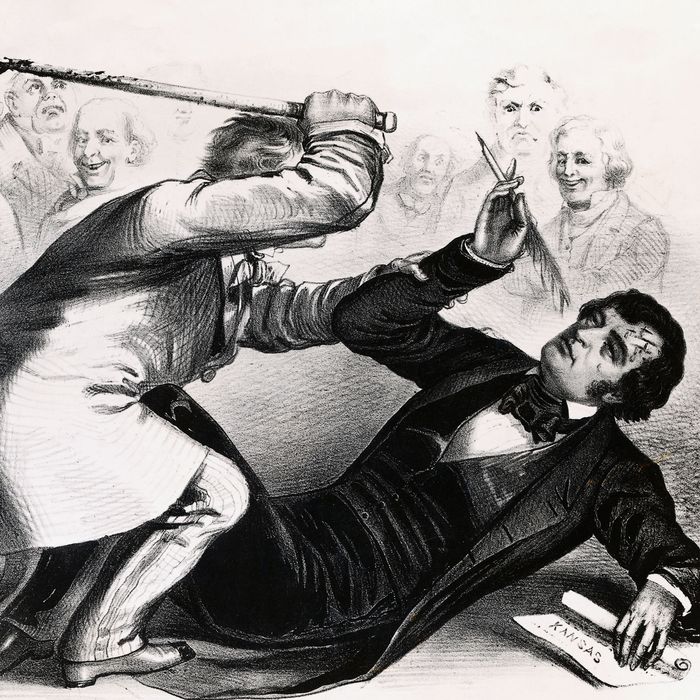Today’s Gridlock Is Like a 19th Century Nightmare

A political cartoon showing Representative Preston Brooks beating abolitionist senator Charles Sumner in the Senate chamber in 1856.
Photo: Bettmann/Bettmann Archive
Going into the 2020 elections, Democrats had high hopes that Joe Biden would win the presidential contest by enough of a margin to ensure solid Democratic majorities in Congress. That was a pretty big deal: After all, in a period of interconnected public-health and economic crises, having one of our two highly polarized parties in a position to get legislation through Congress provided a much better prospect for effective governance than the bipartisanship everyone supports in principle but no one (least of all today’s Republicans) actually practices.
As it happens, Democrats did manage to pull off a trifecta (just as Republicans did in 2016), but by the narrowest possible margins. That outcome, alongside the existence of the Senate filibuster, has forced President Biden to pursue the cramped and complicated budget reconciliation process to enact his initial agenda, with all the perverse implications that come with it (e.g., exclusion of a $15 minimum wage by the Senate parliamentarian). And hanging over every decision Democrats make is the historical probability that they will lose one or both houses of Congress in the 2022 midterms.
If it feels like we’ve lived in this sort of gridlock for a good while, it’s because we have, as Lee Drutman observes at FiveThirtyEight:
[T]he period we find ourselves in now is unique in that the national partisan balance of power is extremely close (with control of national government up for grabs in almost every cycle), even as most states and most voters are either solidly Democratic or Republican. What’s more, the national outcome often hinges on just a few swing states and districts. This period is also unique in the extent to which America is divided. Hatred toward the other party drives our politics. This produces a deeply polarizing and highly destructive form of partisan trench warfare that threatens to erode the very legitimacy of American democracy.
There was a moment, after the 2008 elections, when prophecies abounded that America might support an enduring Democratic majority on the wings of a new “Obama coalition” that would just get larger as younger cadres of citizens began voting. The 2010 midterm disaster for Democrats dashed those hopes, which were briefly revived after 2018, at least so long as it appeared Biden was going to crush Trump in a landslide. No such luck.
As Cook Political Report’s Amy Walter reminds us, today’s volatility is relatively new:
Democrats controlled the House for 40 straight years from 1954 until 1994. Democratic control of the Senate lasted uninterrupted for 25 years—from 1955 to 1980. From 1952 until 1988, Republicans won 7 of 10 presidential elections. This is the era in which many of my peers (and those who mentored me) were raised …
Today, most of those who work in politics don’t know of a time when control of the House, Senate and/or White House wasn’t up for grabs.
Drutman compares the current era to another period of gridlock and polarization: the late 19th-century Gilded Age. From 1876 until 1896, “at least one institution [House, Senate or the White House] changed partisan hands in eight out of 10 elections.” As is happening now, voter turnout was very high with virtually every election having big consequences for partisans. And political contests were intense and even bitter, particularly in the few swing states (typically New York and Indiana) that determined election outcomes more often than not. That sounds familiar, too. Even one of the Gilded Age’s great anomalies — the nonsequential presidencies of Grover Cleveland — is back in the news lately, as defeated President Donald Trump is talking about a 2024 comeback, with even Republicans who don’t like the idea (such as Mitch McConnell and Brian Kemp) quickly saying they will support him if he is, as seems likely should he actually run, the party nominee.
But there is one aspect of today’s polarized gridlock that is unlike that of the Gilded Age, as Drutman notes: In the late 1800s, “the two parties didn’t actually stand for all that much — a stark contrast from today’s politics, where the major parties have distinct policies on a host of national issues.”
The Gilded Age began when sharp partisan differences over the consequences of the Civil War (e.g., whether to impose Black political and economic rights, not just freedom from slavery, on a former Confederacy where white terrorism challenged any sort…
Read More: Today’s Gridlock Is Like a 19th Century Nightmare

